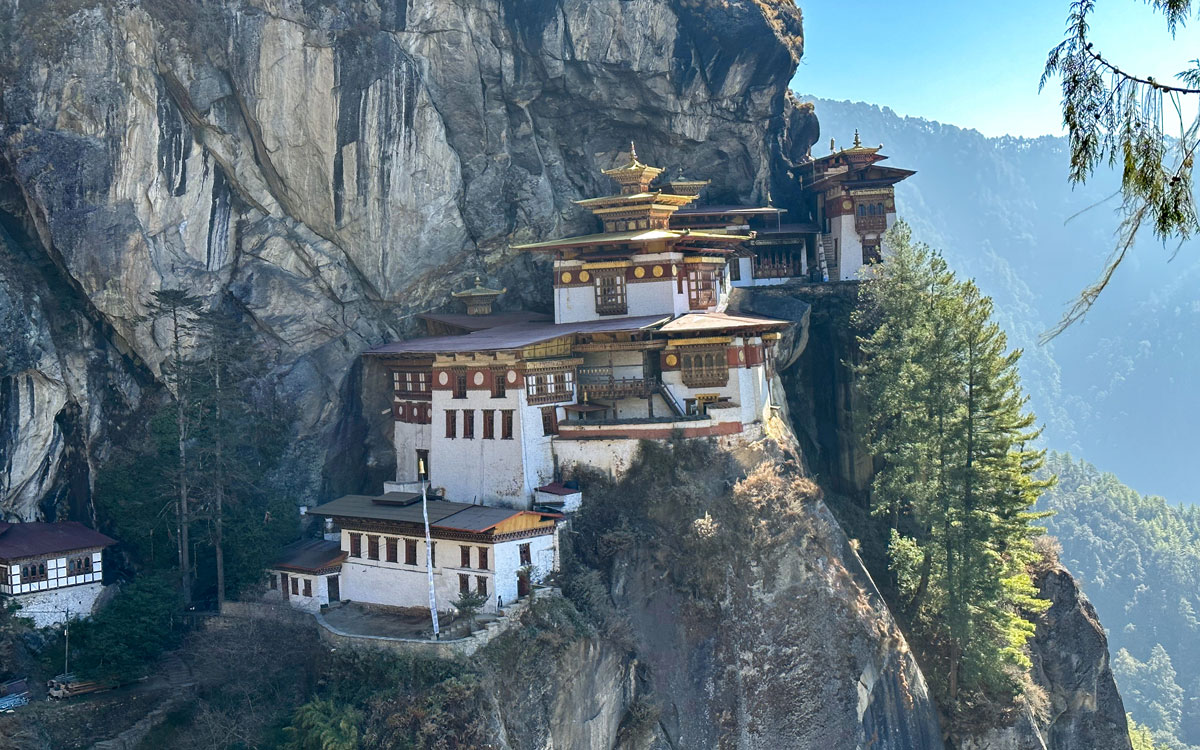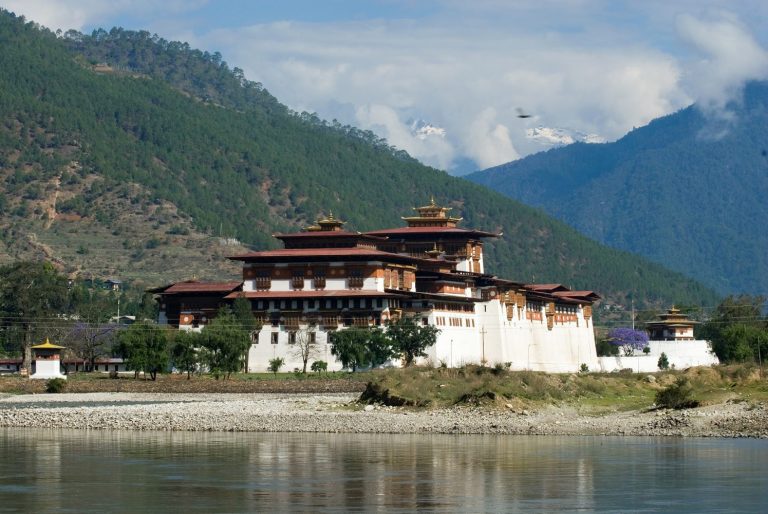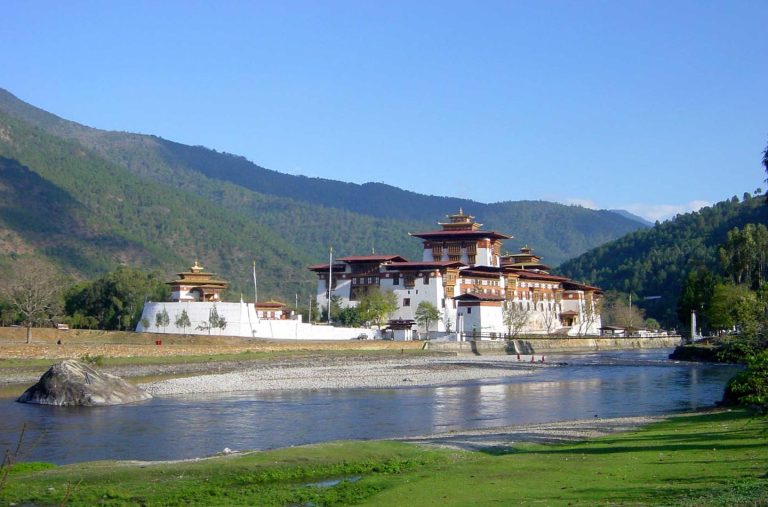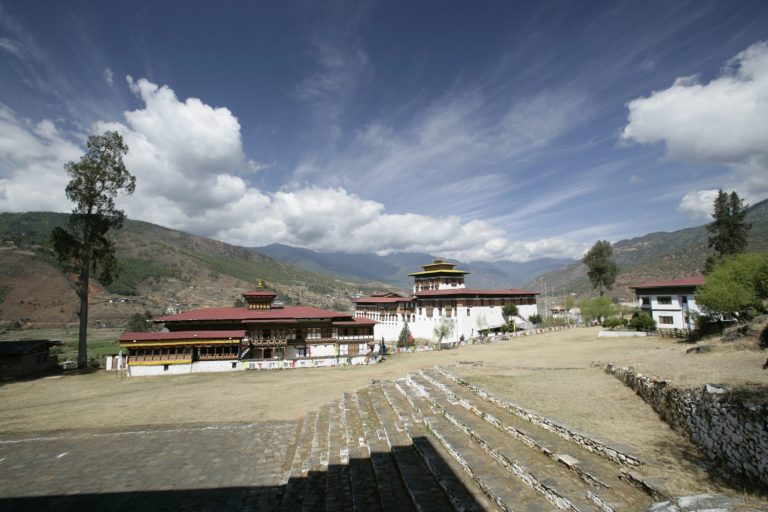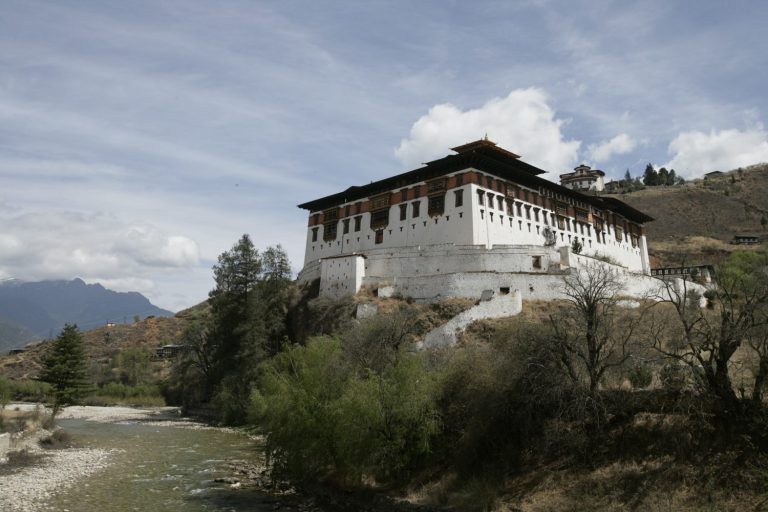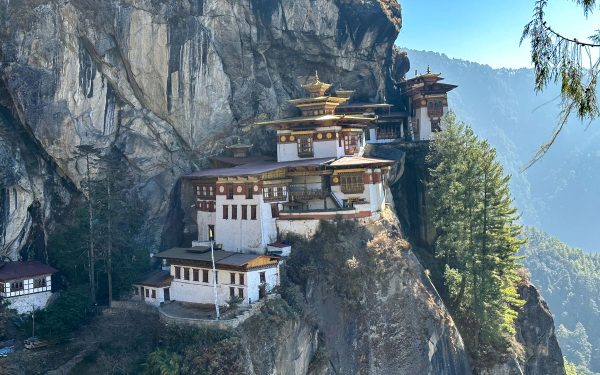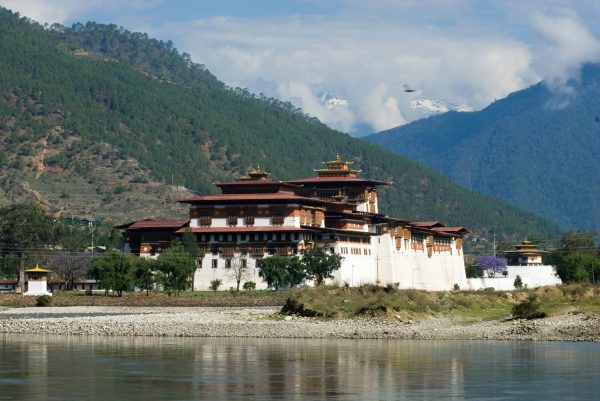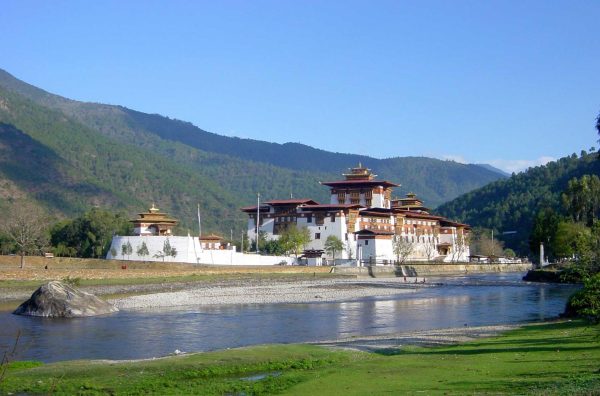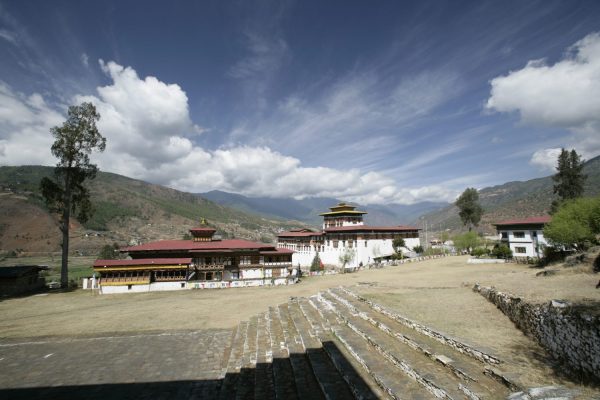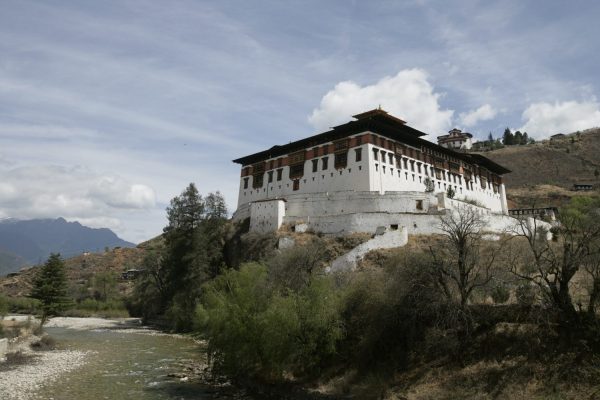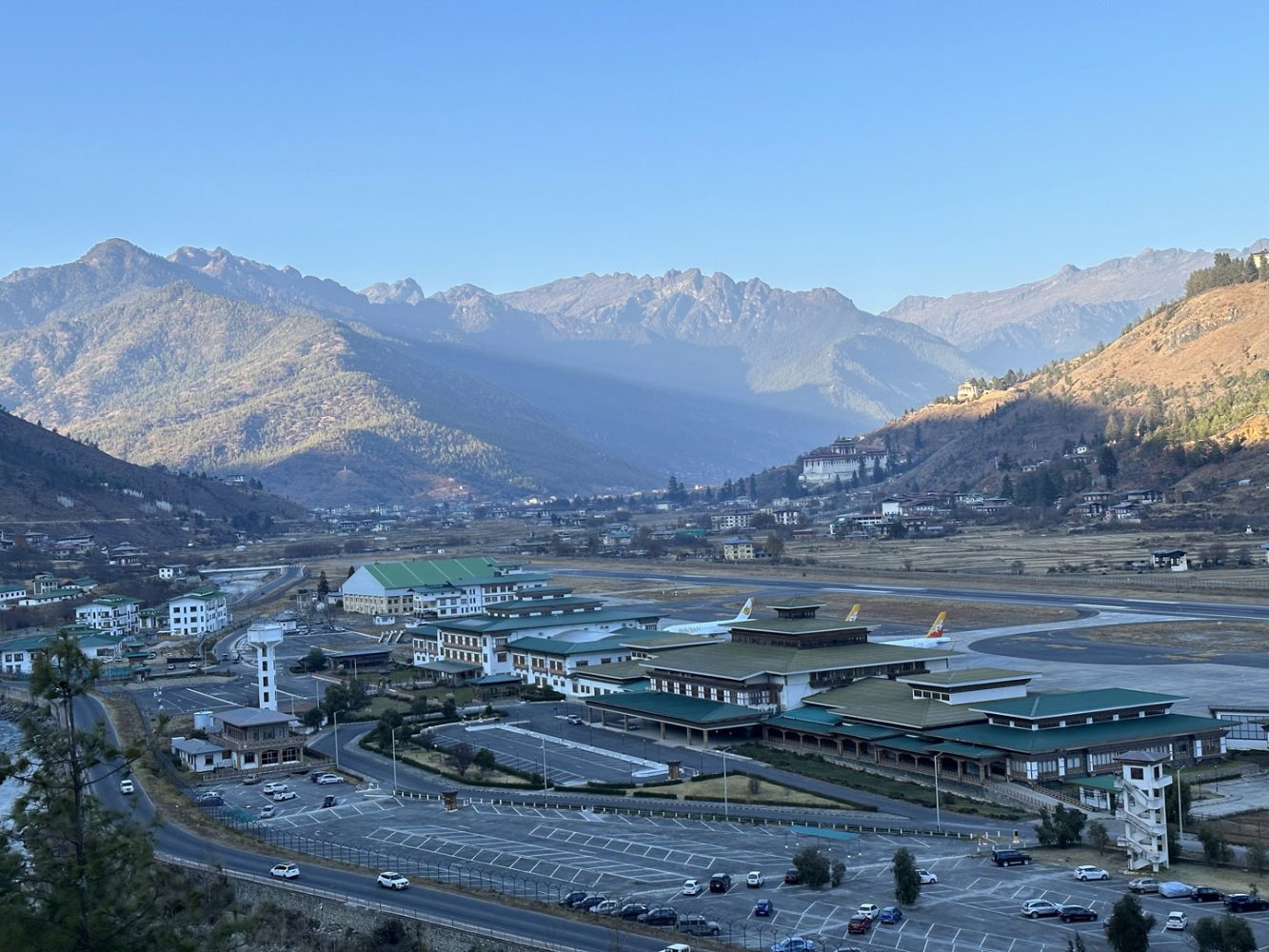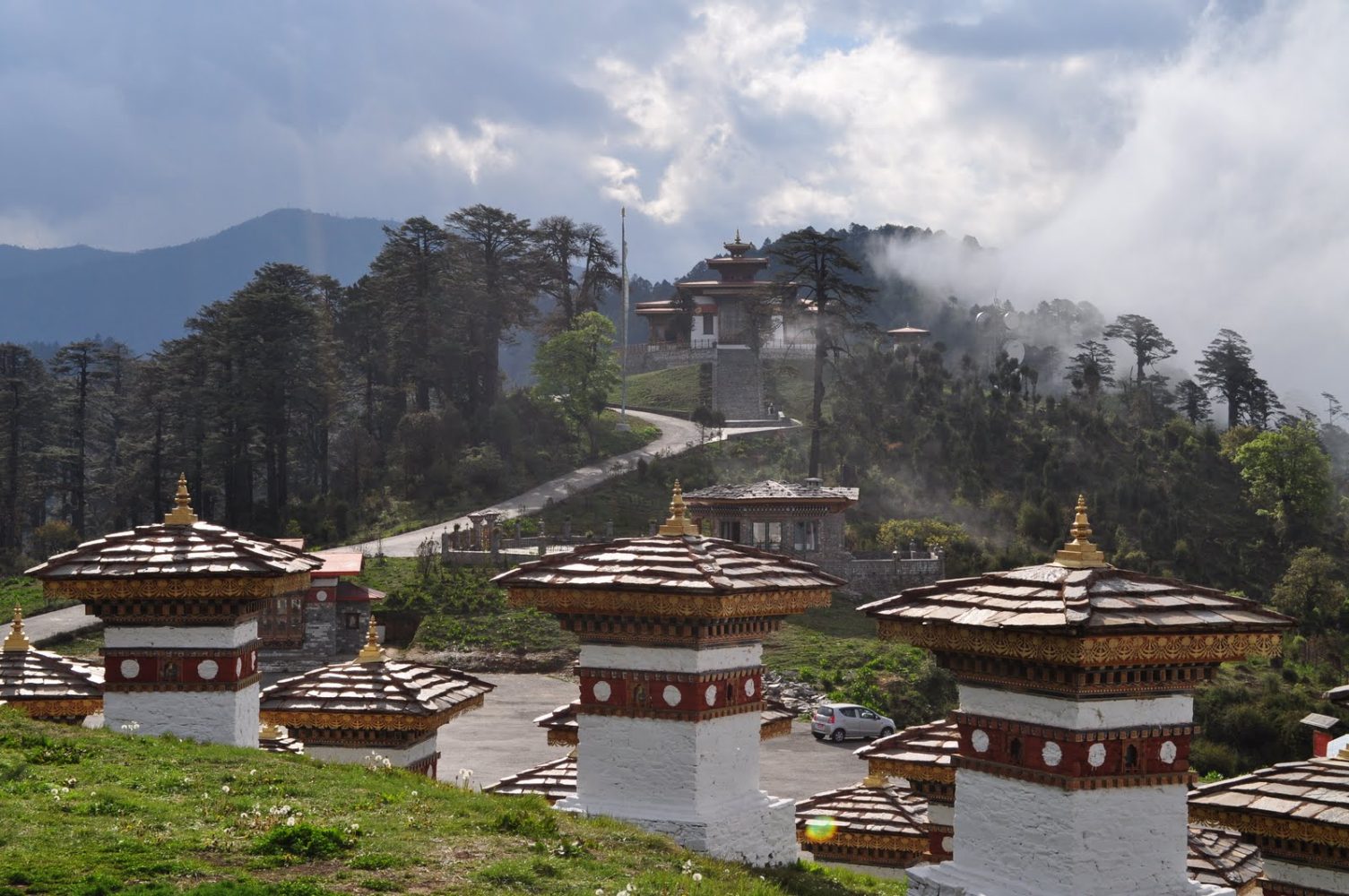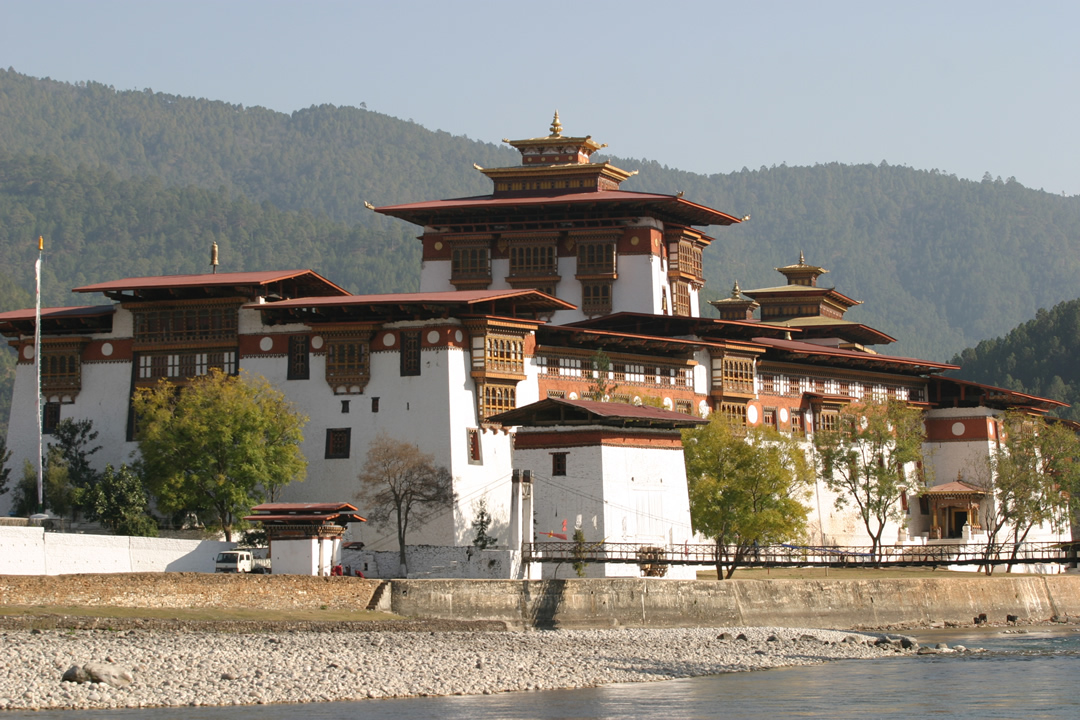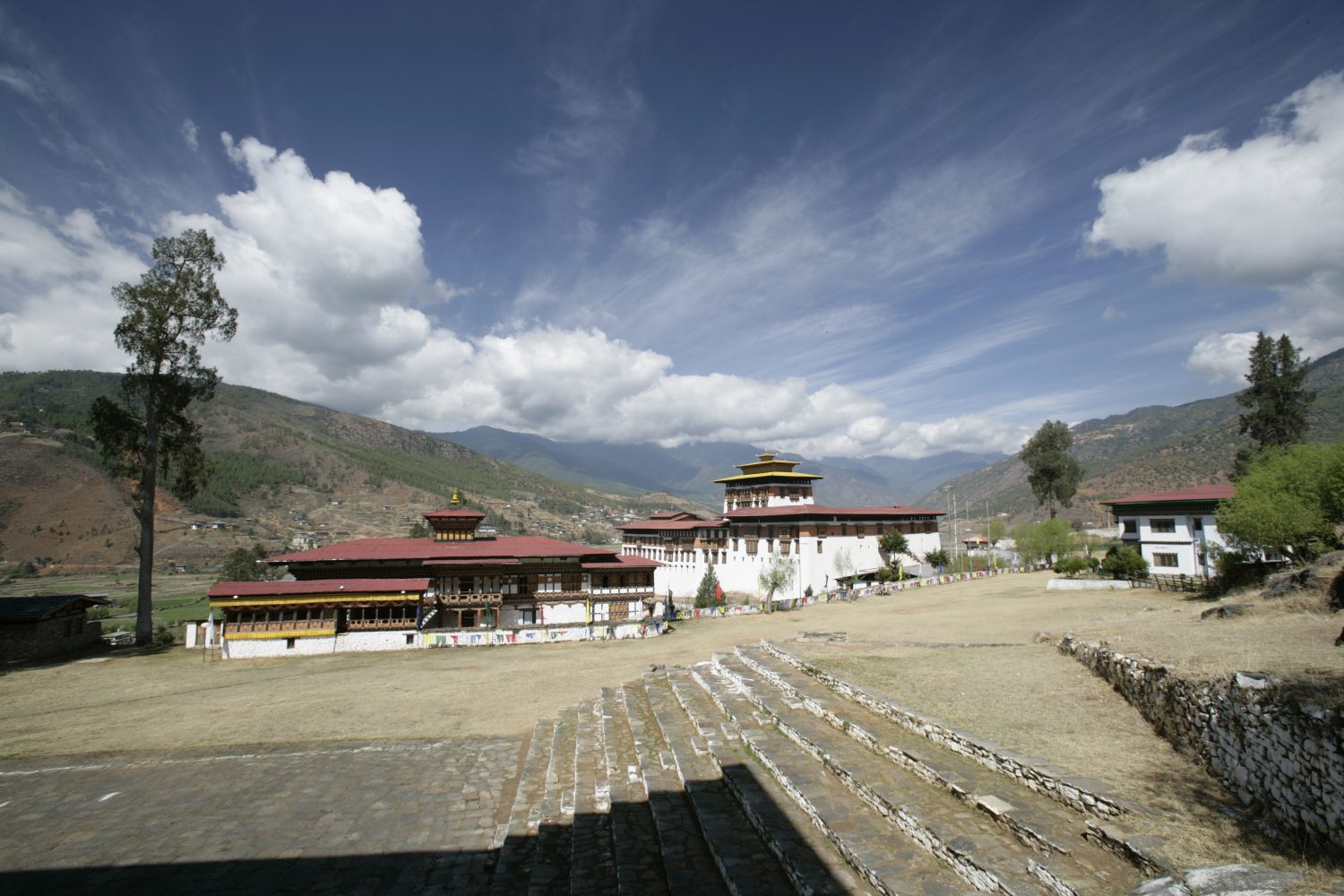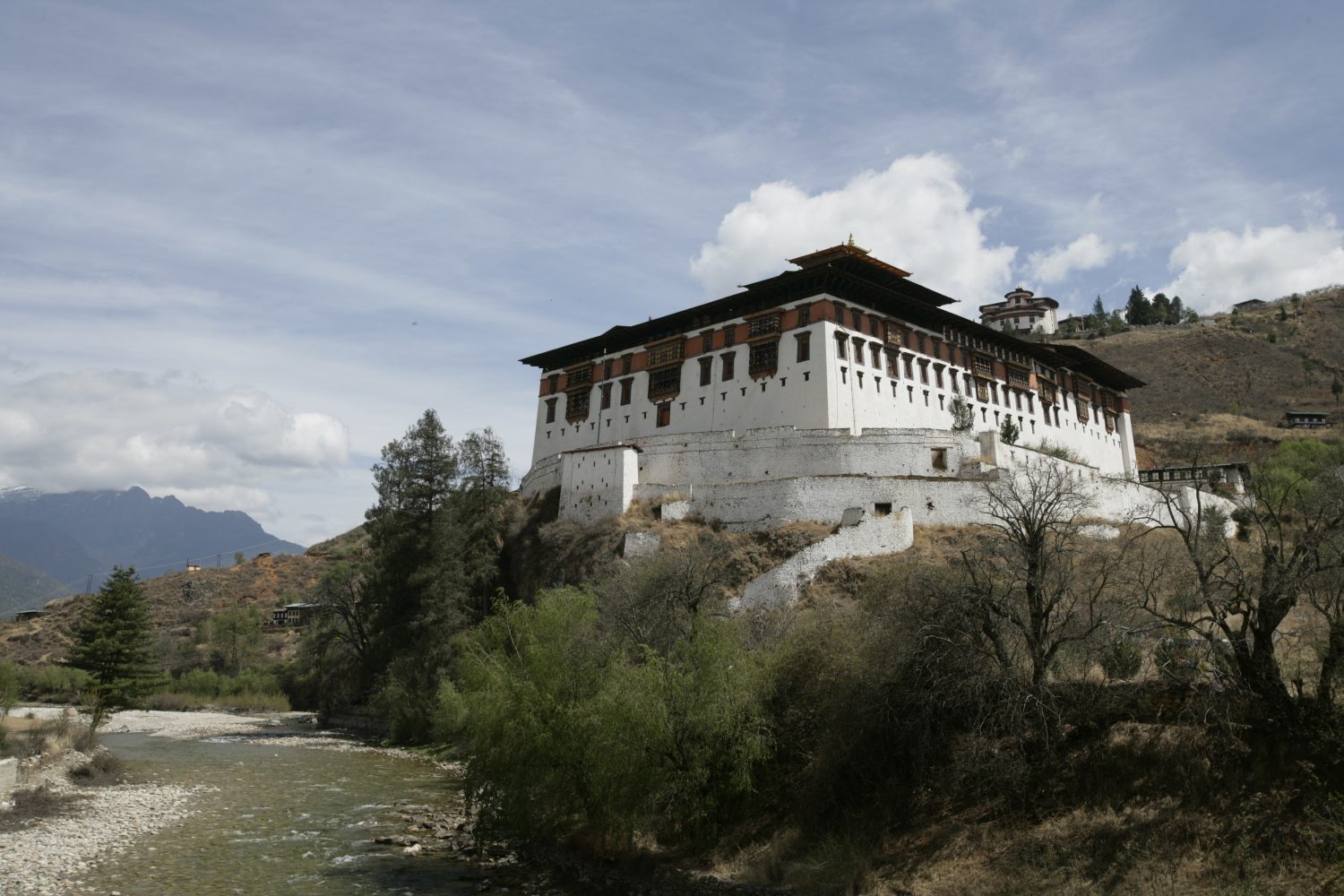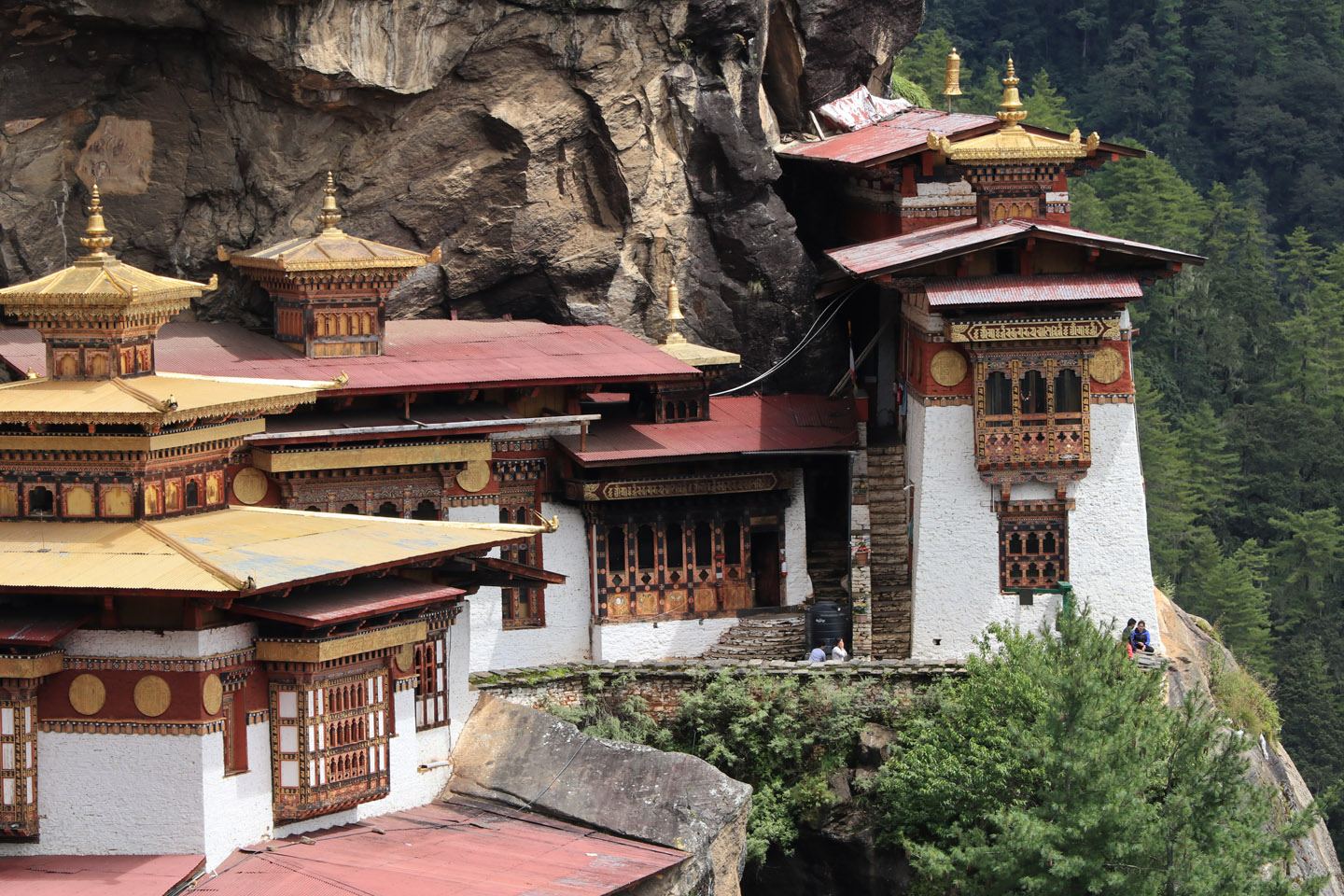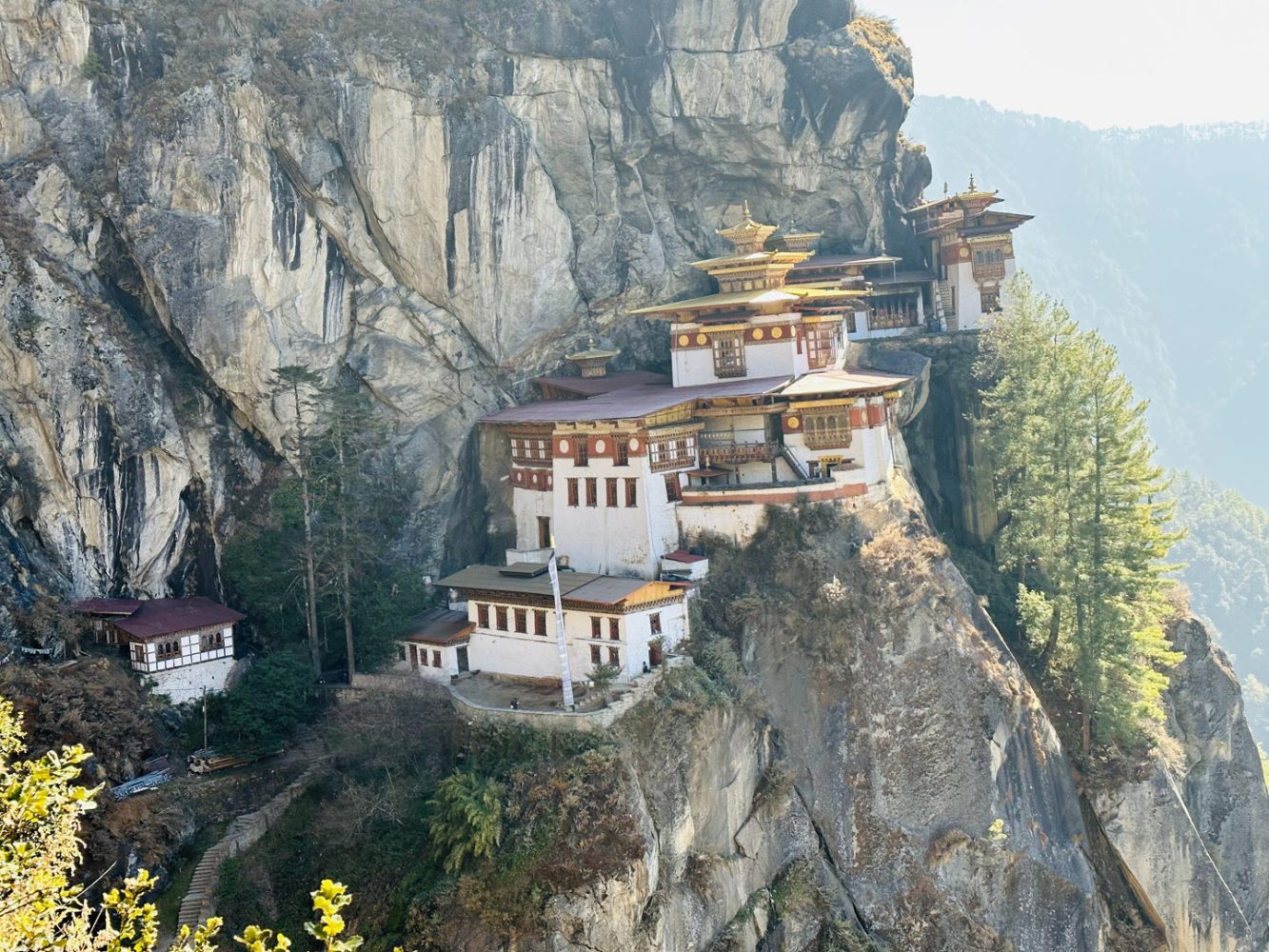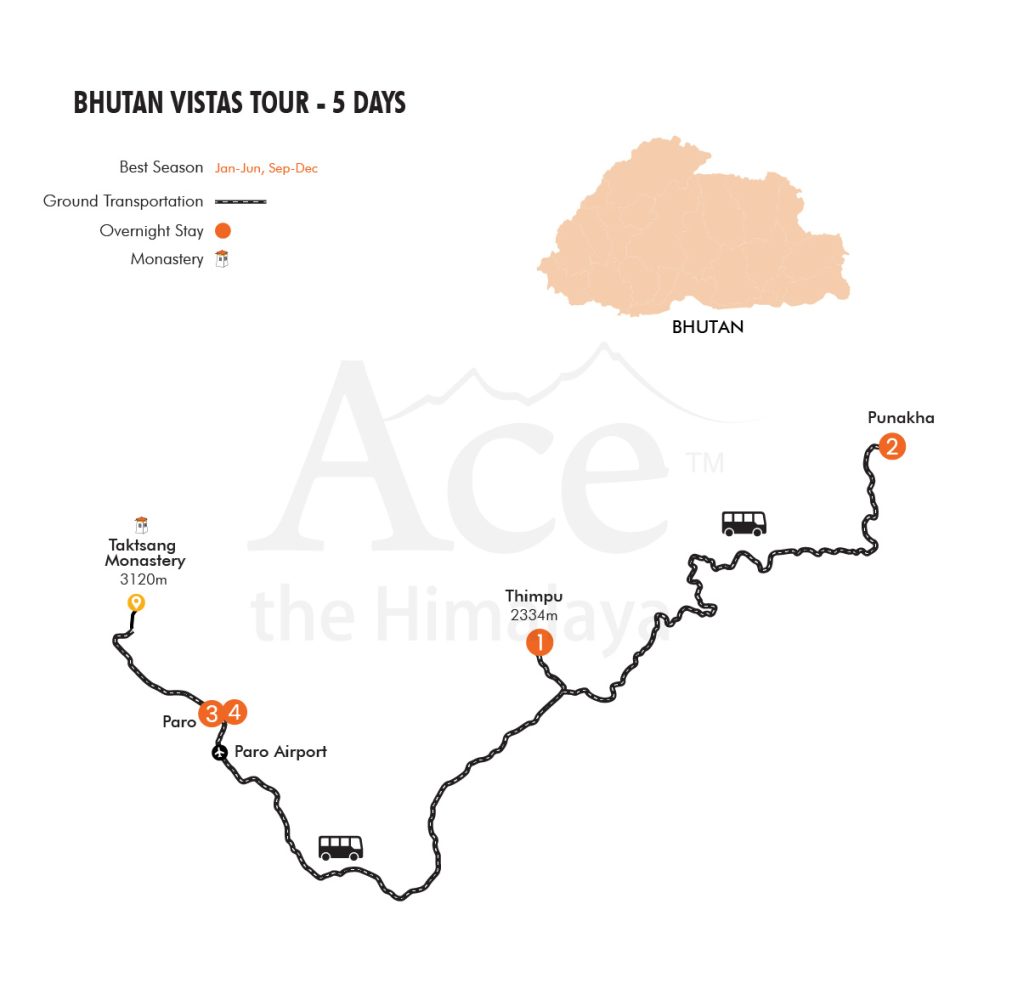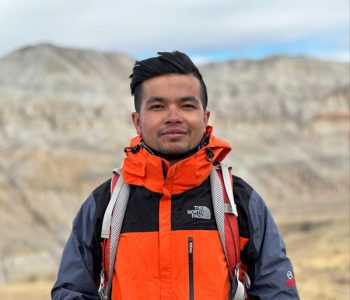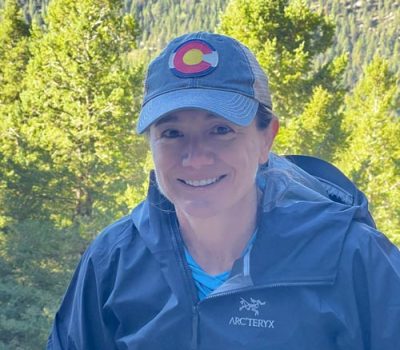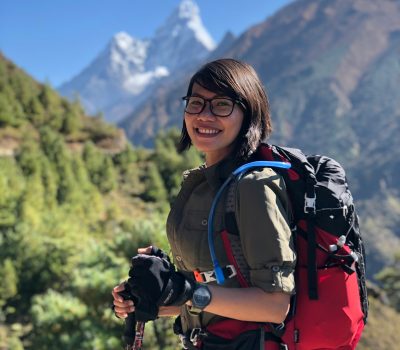Bhutan Vistas Tour - 5 Days
Embark on an unforgettable journey to the Himalayan kingdom with this short yet immersive cultural experience, blessed with pristine landscapes and rich encounters with Buddhist culture.
Bhutan Vistas Tour Highlights
- Explore the charming capital city of Thimphu, nestled in the Himalayas.
- Visit the majestic fortress-monastery Tashichho Dzong, home to the throne room and offices of the King.
- Hike to Bhutan’s most iconic and sacred cliffside monastery, Taktsang Monastery (Tiger’s Nest), and enjoy its awe-inspiring views.
- Browse traditional handcrafted Bhutanese arts and crafts, perfect for unique and meaningful souvenirs.
- Marvel at the architectural beauty of Punakha Dzong, the “Palace of Great Happiness,” located at the confluence of two rivers.
- Discover the ruins of the historic Drukgyel Dzong (Victory Fortress), built to commemorate Bhutan’s victory over Tibetan invaders.
Trip Overview
Step into the heart of the last Himalayan kingdom with our carefully crafted Bhutan Vistas Tour, where tradition meets tranquility.
Explore the vibrant capital, hike to sacred monasteries, breathtaking panoramic landscapes, and discover Bhutan’s architectural marvels, all while soaking in the serene charm of this magical kingdom.
This 4-night, 5-day experience is perfect as an enriching extension to your broader holiday. Whether you’re seeking a peaceful cultural immersion or soaking in scenic exploration, this tour offers the perfect balance.
Begin your journey in Thimphu, the charming capital city nestled in the heart of the Himalayas, where tradition and modernity coexist in perfect harmony.
Visit the majestic Tashichho Dzong, a magnificent fortress monastery that serves as the seat of the King’s offices and a center of spiritual life.
Continue your adventure with a hike to the iconic Taktsang Monastery (Tiger’s Nest), dramatically perched on a cliffside and offering awe-inspiring views of the surrounding valleys.
Immerse yourself in Bhutanese craftsmanship as you explore traditional handcrafted arts and crafts which are ideal for meaningful and unique souvenirs.
In the former capital of Punakha, admire the stunning Punakha Dzong, also known as the “Palace of Great Happiness,” gracefully situated at the confluence of the Pho Chhu and Mo Chhu rivers.
Finally, conclude your journey at the historic ruins of Drukgyel Dzong (Victory Fortress), built to commemorate Bhutan’s triumph over Tibetan invaders, a national pride and resilience symbol.
Short Itinerary
Arrival at Paro (by Druk Air), then transfer to Thimphu (2,330 m/7,644 ft) – 1 hour drive. Overnight at a 3-star hotel.
Drive to Punakha (1,200 m/3,937 ft) from Thimpu – 2 hours drive. Overnight at a 3-star hotel.
Drive to Paro (2,250 m/7,382 ft) from Punakha – 3 hours drive. Overnight at a 3-star hotel.
Excursion to the Taktsang Monastery (Tiger’s Nest) at 3,120 m (10,232 ft) – 20 minutes drive then 5-6 hours hike. Overnight at a 3-star hotel.
Transfer to the international airport for your final departure.
Departures & Availability
Use the calendar below to choose your desired travel date. You can either join one of our fixed group departures or opt for a private trip if you prefer a more personalized journey. Simply pick the date that works best for you, and follow the steps to confirm your booking.
Use the calendar below to choose your desired travel date. You can either join one of our fixed group departures or opt for a private trip if you prefer a more personalized journey. Simply pick the date that works best for you, and follow the steps to confirm your booking.
Looking for personalized experience? We organize privately guided journey which is mainly designed to fit your taste and interest. Please fill out the form below to get started.
Price Includes
Accommodation
- Standard government-approved 3-star accommodation (in twin-sharing rooms) for the duration of the tour.
Meals and Drinking Water
- Full-board meals – 4 breakfasts, 4 lunches, 4 dinners, and tea & snacks – for the duration of your stay.
- Unlimited supply of packaged drinking water for the duration of the tour.
Transportation
- All (international and domestic) airport transfers on a tourist vehicle
- Private transportation and a designated driver within Bhutan. SUV vehicles for solo/pairs, Hiace vans for small groups, and Coaster buses for larger groups.
Guide and Staff
- Licensed English-speaking and first aid experienced Bhutanese tour guides. Additional or assistant guides are provided for groups over 11 or when special support is needed, such as for senior travelers.
- Guided city tour in Paro by private tourist vehicle.
- The required number of local staff and porters to carry your luggage during the trip.
- Wages, accommodation, meals, gear, insurance, and medications for all staff
Permits and Fees
- Bhutan visa fees and processing assistance.
- All route access and monument entry permit and fees.
- Monument and museum entrance fees for all sightseeing locations are detailed in the itinerary.
- Government-mandated Sustainable Development Fee of US$100 per person per night.
Benefits and Takeaways
- Country presentation and tour Briefing on the evening of Day 1 with welcome drinks.
- 1 Ace the Himalaya’s duffel/kit bag, sun hat, and Buff (Neck Gaiter) if your flight originates from Kathmandu, Nepal.
Administrative
- All government taxes, official expenses, and tourist service charges.
Price Excludes
- All international airfare, including Druk Air flights and airport departure tax
- Travel insurance, along with high-altitude emergency evacuation coverage.
- Alcoholic drinks and beverages.
- Tips for tour guides, porters, drivers, hotel lobby, and restaurants. (Tipping is expected).
- All items of a personal nature like laundry, gear, shopping, etc.
- Any expenses other than the Price Include section.
Bhutan Vistas Tour Itinerary
Expand AllDay 01: Arrival at Paro (by Druk Air), then transfer to Thimphu
You can fly directly to Paro International Airport from major Asian hubs like Kathmandu, Bangkok, New Delhi, and Dhaka.
For the most convenient travel experience, we recommend flying from Kathmandu-Paro-Kathmandu, for a seamless transfer and smooth operations. This route also allows us to provide you with convenient service and necessary takeaways such as a duffle bag, sun hat, and neck gaiter which are yours to keep after the trip.
As you soar through the skies, you’ll enjoy one of the world’s most breathtaking flight experiences, with panoramic views of the Himalayan giants, including Mount Everest, before landing in the picturesque Paro Valley perched at 2,250 m(7,382 ft) above sea level.
This lush, fertile region is famous for its golden rice fields, apple orchards, and fresh organic produce.
Upon arrival, your Bhutanese guide will welcome you with a traditional silk scarf (khata), a symbol of good fortune. After completing arrival formalities, you’ll embark on a scenic one-hour drive to Thimphu, Bhutan’s charming capital.
Along the way, you’ll pass through terraced rice fields and traditional farmhouses, quaint mountain villages with stunning valley views, and the sacred river confluence marked by three Buddhist stupas- a spiritual monument believed to ward off evil spirits
In Thimphu the total population is 114,551 according to the recent census, you’ll explore the vibrant local market, witness thrilling archery matches (Bhutan’s national sport), and discover why this is the world’s only capital without traffic lights.
With just a few main streets lined with shops and cafes, you’ll immediately feel the peaceful, unhurried charm of Bhutanese life.
Day 02: Drive to Punakha from Thimpu
After enjoying breakfast at your hotel, you’ll embark on a breathtaking drive to Punakha via the spectacular Do Chula Pass (3,080 m/10,104 ft).
As you ascend, you’ll notice traditional Bhutanese chortens and fluttering prayer flags marking the pass. On vibrant days, you’ll be rewarded with scenic panoramic views of the snow-capped peaks of the eastern Himalayas.
Your first stop is the magnificent Punakha Dzong (Palace of Great Happiness), strategically built in 1637 at the confluence of the Phochu and Mochu rivers.
This architectural masterpiece once served as Bhutan’s religious and administrative heart, and you’ll marvel at its towering, whitewashed walls, golden spires, and intricate woodwork.
Later, you’ll visit the famous Chimi Lhakhang, affectionately known as the “Temple of Fertility”. Nestled on a picturesque hillock, this sacred site is believed to bless childless couples who pray here.
You’ll enjoy a peaceful walk-through lush rice fields and the charming village of Pana (“field”), where you can observe local farmers livelihood.
Day 03: Drive to Paro from Punakha
After breakfast, you’ll begin your return journey to Paro, descending from the breathtaking Dochu La pass and winding through the dramatic Wang Chhu and Paro Chhu River valleys.
As you approach picturesque Paro Town, you’ll make several fascinating stops to immerse yourself deeper in Bhutan’s rich culture.
First, you’ll visit Simtokha Dzong – Bhutan’s oldest fortress, known as the “place of profound tantric teaching.” This historic dzong serves as a Dzongkha language institute, where you can observe students preserving Bhutan’s linguistic heritage.
Next, you’ll explore Ta Dzong, an ancient watchtower that now houses the National Museum of Bhutan.
Here, you’ll discover exquisite thangka paintings, traditional textiles and weapons, rare household artifacts, and fascinating natural history exhibits.
Your cultural journey continues with a short walk down to Rinpung Dzong (“Fortress of the Heap of Jewels”).
As you explore this architectural masterpiece, you’ll admire intricate wooden galleries, stunning wall paintings depicting Buddhist parables, and iconic Buddhist imagery, including the Four Friends, Wheel of Life, and Mount Sumeru mandalas.
Day 04: Excursion to the Taktsang Monastery (Tiger’s Nest)
After an early breakfast, you’ll embark on Bhutan’s most iconic adventure – the 5-6 hour hike to Taktsang Monastery (Tiger’s Nest), dramatically perched 900m above the Paro Valley.
This sacred cliffside temple, where Guru Rinpoche is said to have arrived on a flying tigress, is considered Bhutan’s most holy site.
Though damaged by fire in 1998, the monastery has been beautifully restored to its former glory and remains a must-visit pilgrimage site for all Bhutanese.
Your spiritual journey continues at the 7th-century Kyichu Lhakhang, one of Bhutan’s oldest temples, built by the Tibetan King Songtsen Gampo. This sacred site marks the introduction of Buddhism to Bhutan and features stunning ancient architecture.
As evening falls, you’ll enjoy a leisurely stroll through Paro’s charming main street, where you can browse colorful local markets, shop for authentic Bhutanese handicrafts, and soak in the authentic atmosphere of a traditional Bhutanese town.
Day 05: Transfer to the international airport for your final departure
After an early breakfast at your hotel, your unforgettable Bhutan journey comes to a close as we transfer you to Paro International Airport for your onward flight.
Our friendly representative will assist you with all departure formalities and ensure a smooth check-in process before bidding you with traditional Bhutanese farewell.
Gears and Equipment
All you need to bring for this Tour is simply some comfortable clothes; there is no requirement for special equipment on the tour.
However, for your ease, the following gives you a general idea about the personal items you need to manage for the trip. The personal items referred to here are optional and depend upon your choice.
The most important factor to be considered while choosing the types of equipment and your Bag-pack is the time of the year you are travelling.
In a tour, the vehicle transfers all the heavy items and equipment. But the Personal belongings of the clients which are required at any moment like money, water bottle, camera, sunscreen, and toilet paper, etc. should be carried by yourself.
It is therefore advisable that you pack your personal belongings into your daypack.
If you’re flying from Kathmandu, we’ll provide you with a complimentary, windproof duffel bag for the trip. This bag will be carried by porters or mountain transportation like mules, and horses in high-altitude regions and is yours to keep after the trip.
List of Recommended Equipment
- Duffel or Rucksack bag or suitcase (We will provide one complimentary ACE duffel bag for you to keep.)
- Daypack
- Warm wool or synthetic hat that covers your ears (only if you are travelling in the cold season i.e January, February, and December)
- Goggles or sunglasses for sunbeams, dust, and wind.
- A neck warmer is another piece of gear for extra warmth if you feel you will need it and is for cold season i.e January, February and December. (optional)
- 1 pair warm gloves (This is required if you are travelling in cold season i.e January, February and December).
- T-shirts (2).
- Waterproof (preferably breathable fabric) shell jacket (preferable if you are travelling in rainy season from June to September.)
- 1 pair cotton pants (loose jeans/khakis), 1 pair shorts.
- 2 pairs lightweight long underwear/thermals (if you are traveling in winter January, February, and December).
- 2 pairs of liner socks, synthetic or capilene.
- 1 pair light camping shoes or sneakers.
- 1 pair sandal (Optional)
Medicines and First Aid Kits
(Please note our guide will also carry the first aid kit bag during the trip. However, we still recommend you bring your personal first aid kit as well)
- Extra Strength Excedrin for altitude related headaches.
- Ibuprofen for general aches and pains.
- Immodium or Pepto bismol capsules for upset stomach or diarrhea.
- Diamox (commonly prescribed as Acetazolamide) 125 or 250mg tablets for altitude sickness. Please discuss with us before starting to take this medicine.
- 1 small personal sized first-aid kit with blister treatments such as mole skin, band-aids, some waterproof tape, anti-infection ointments, etc. Your guides will have more extensive medical gear, but you should have the basics for general use.
Other Essentials
- Passport and extra passport photos (4 copies).
- Airline ticket (Please make a copy and leave on at our office in KTM just in case if you need to change the date of your).
- Durable wallet / pouch for travel documents, money & passport.
- Lip balm. At least SPF 20, 2 sticks. A string taped to the stick is helpful; to hang around your neck and some are now being sold with a cord already attached. Handy as it avoids you from having to stop and look for it.
- Sunscreen. SPF 40 is recommended and should be relatively new since it loses its’ effectiveness over time.
- Pocket knife or small Swiss Army type.
- Water purification Iodine tablets or Polar-pure crystals.
- Toiletry kit. Be sure to include toilet paper stored in a plastic bag, hand wipes, and liquid hand sanitizer, towel, soap, etc.
- 2 bandanas.
Optional
- 1 pair adjustable trekking poles. Although these are listed as optional, they can be of great assistance especially when going downhill (Optional).
- Favorite snack foods, no more than 2 pounds (Optional).
- Paperback books, cards, mp3 player (there are a couple of stops where you could recharge. Avoid players with moving hardware as it may not function. Remember, keep these items lightweight (Optional).
- Binoculars (Optional).
- 1 lightweight point-and-shoot camera or 1 large SLR. Digital cameras are ok, but you must keep the batteries warm when not in use (Optional).
- Hydration bladder with drinking tube and tube insulator (Optional).
- A pee bottle for men and a pee funnel for women, some swear by them to avoid that chilly late-night trip (Optional).
- 1 small stainless-steel thermos (Optional)
This list is only a guide. While you are required to bring everything on this list, there are numerous options, brands, and versions of each piece of equipment. Use your experience and the listed features to find the best gear for you.
Trip Video
FAQs for Bhutan Vistas Tour
General
Is this a guaranteed departure for dates listed on the website?
Yes, this trip offers guaranteed departures on the specified dates. You can view and select available departure dates directly from the booking calendar on our website. Each listed date is confirmed to operate. Furthermore, Bhutan trips must be booked at least one month in advance due to travel regulations and logistics.
Additionally, we provide group discounts based on the size of your group. The larger your group, the more substantial the discount, enhancing your travel experience.
Are Bhutan trips available as group departures or only as private journeys?
Normally, most of the Bhutan trips are private departures, meaning they are organized based on preferred dates, an excellent option for families or friends traveling together.
However, if you’re interested in an open-group departure for Bhutan, please inquire with us at the time of booking.
Why travel with Ace the Himalaya?
Ace has a reputation for successfully leading treks with knowledgeable leaders and staff taking care of all your travel needs. We are a certified sustainable travel company that also endorses the idea of giving back to the community by participating in various philanthropic activities. Here are 17 reasons to hike with Ace the Himalaya.
What essential documents do I need to bring with me on tours?
Here are some documents that you will need to carry with you:
- Valid Passport – must be valid for up to 6 months after you return from your tour (Keep a separate photocopy)
- Travel insurance (Keep a separate photocopy)
- Cash and Traveller’s Cheques (Keep numbers and proof of purchase separately)
- Flight tickets
- Emergency contact numbers for T/C’s, banks, insurance, family contacts
Weather and Temperature
What is the best season for Bhutan Vistas tour?
The best time for Bhutan tours is between February to June and between September and December.
What is the weather and temperature like on the tour?
It depends on the season you’re traveling. During winter (December to February), it is colder at night and relatively warmer during the day, with the temperature ranging from 4°C at night to 22°C. Between March and May, the weather stays perfect as the temperature averages 25°C during the day.
From September to December, following the monsoon, the temperature gets cooler and allows for a great time to travel. The average temperature during this season is 20°C. The vehicles and the hotels during the trip will be air-conditioned making your travel very comfortable.
Arrival and Visas
Do I need to obtain VISA for Bhutan?
We will handle the visa procedures for you. The Govt. will sanction the VISA only after the receipt of full payment in advance. The visa fee is included with our tour price. Actual Bhutan VISA will be stamped in your passport on arrival on Paro airport. Without visa clearance number, tourists cannot board the flight or enter the country.
The Ministry of Foreign Affairs forwards a copy of this visa clearance to the concerned Druk Air stations and other entry points; we also fax a copy of the visa clearance document to our clients for their reference. While the actual visa is stamped on arrival, the initial visa clearance is also required at the time of issuing Druk Air Tickets.
All you need is to carry 2 copies of original passport-sized photographs, which are required on arrival in the country. Please e-mail us the clear color copy of the passport for the visa procedures.
Will somebody come to pick me up at the airport upon my arrival?
Yes, our airport representative will be there to greet you at the airport. S/he will be displaying a sign board with your name on it at outside the airport terminal. Upon arrival, you will be transferred to your hotel by our tourist vehicle.
Payments and extra costs
How much additional money do I need per day?
It depends on your personal spending habits. In general, all meals, accommodation, and hot drinks are included in the trip price.
You may want to budget around USD 10 to USD 20 per day for additional beverages such as soft drinks, chocolates, or occasional treats.
For personal expenses such as laundry, shopping, bar bills, and tips the amount will vary depending on individual preferences and consumption. These costs are not included in the package and should be planned based on your experience and spending habits.
Can I use credit cards in the places visited in tour?
There are just a few ATM’s in Bhutan for credit cards (Master card / Maestro) & only a few establishments in Bhutan accept credit card payments hence US Dollars (cash or Amex traveler’s cheques) or Euros Cash is suggested and convenient to cover any personal expenses (eg. beverages, laundry, phone bills, tipping, shopping, etc) that the Pax may make in the Kingdom.
1US$ is equivalent to Nu. 84.33 & 1 Euro is equivalent to Nu.95.54 as of today (the day we are writing this text). NU= Ngultrum, the Bhutanese currency.
Who Can Participate?
How fit do I have to be and is this tour for me?
This culture tour is suitable for any kind of travelers ranging from all age groups, no previous experience is required. It’s designed to be accessible and enjoyable for anyone with a general level of health and mobility.
That said, engaging in light physical activity such as aerobics or walking in the weeks can help you feel more comfortable and enhance your overall experience, especially during short hikes or walks included in the itinerary.
Accommodation
What sort of accommodation can I expect in tour?
Accommodation includes a combination of comfortable hotel stays and well-equipped tented camps. In cities like Thimphu and Paro, you are accommodated in a minimum of 3-star deluxe hotels.
Upgrades to 4-star semi-luxury or 5-star luxury hotels can be arranged upon request, with applicable supplement charges.
What sort of food can I expect in tour?
Most restaurants in Bhutan offer an eclectic mix of Bhutanese, Nepalese, Indian, Chinese, Western, and Continental cuisine, ensuring there’s always plenty to choose from. Local Bhutanese dishes tend to be spicy, similar to Indian cuisine, and provide a rich cultural culinary experience.
Is the water available drinkable? Do I need to bring purifying tablets/filters?
No, you don’t need to bring any purifying tablets or water filters for the Bhutan trip.
The trip price includes an unlimited supply of safe, packaged drinking water for the entire duration of the tour. This ensures you stay well-hydrated without any additional cost or concern about water safety.
Will it be possible to get any clothes washed/Laundry ?
Laundry service is easily available at your hotel. Please note that laundry service is not included in the package price.
Can I charge my digital camera or other equipments on my trip?
These facilities will be available in most of the places in your hotel. Remember to bring travel adapters!
Health and Safety
Is Ace the Himalaya's staff insured?
Our company insures all our trekking staff members, including guides, cooks, Sherpa, and porters. Please browse through our legal docment page to view insurance details.
What immunizations will I need?
No vaccinations are compulsory for traveling in Nepal, but we do recommend you are covered for diphtheria & TB, hepatitis A, hepatitis B, *malaria, typhoid, polio, and tetanus.
We also recommend:
- A dental check-up prior to traveling
- Know your blood group in case of an emergency
If you have any pre-existing medical conditions that might affect you on tour, you make these known to your tour leader and Ace the Himalaya at the time of your booking.
Practical Matters
What is your cancellation policy?
Notice should be provided 20 days before the trip start date in case of cancellation. The trip can be canceled for justifiable reasons. Once the trip is canceled, a fee of 30% of the trip cost is retained for administrative costs.
However, the trip amount is entirely non-refundable if the cancellation is not made before the 20 days as per our terms and conditions. For submitting a claim to your insurance company after the cancellation, we can assist with documentation such as a receipt of monies paid. Refund will not be provided for unused accommodation in case of trip cancellation caused by personal reasons/sickness/weather.
More information about our cancellation policy can be found here in Terms and Conditions page.
Do I need to tip my guide and porters? How much would that be?
This is a difficult thing to gauge. We have seen everything from USD 20 to USD 1000 per person for guides and porters. Tipping is not required, but a small gesture of thanks to your guides and local porters thanking and appreciating their help. The level of the tip should reflect the level of satisfaction from and personal involvement with your guide.
When do you provide an assistant guide for group tours?
An additional guide is provided for groups of 12 or more participants. However, we may also assign an assistant guide depending on the age group of the participants (e.g., for senior citizens) or if special assistance is required.
Is the government-mandated Sustainable Development Fee (SDF) of US$100 per person per night still applicable?
All SDF charges are included in your package, so you do not need to pay anything extra.
The government-mandated SDF is US$100 per person per night. Children under 12 years old are eligible for a reduced rate of US$50 per child per night, and there is no SDF charged for children under 5 years of age.
Are there any communication facilities during the trip?
Telephones and Internet and international calls are readily available in most of the town for this trip.
Are there any photography restrictions?
You will have many photo opportunities during the trip. Please ask for permission before taking a person’s photo. Photography in, monasteries, shrine rooms of Dzongs, and religious institutions is generally not permitted, but outdoor photography is.
To be sure when visiting such places, you may consult with your guide just to make sure. Carry plenty of films and batteries. Photo shops in Bhutan do not sell equipment or accessories.
Can I add extra days to my trip?
No, because we can’t change your Druk air flight once it is booked.
Is there a minimum and a maximum number for your groups?
We cater to all group sizes, while maintaining the field staff ratio to give you the best quality and experience.
Transportation and flights
Do we book our international flights and Druk air flights?
Yes, you will need to book your international flights (to/from Asia, Europe, or other continents) independently. We are a local agent, and booking international flights through us could result in higher costs.
However, Druk Air and Bhutan Airlines are the only two airlines that operate flights to and from Bhutan (Paro International Airport).
We can assist you with booking Druk Air flights to and from Bhutan and will email you the e-tickets once booked.
Please note:
- Druk Air flights are not included in the trip price.
- Flight fares vary depending on route, season, and forex rates.
We recommend flying from Kathmandu, Nepal, for a seamless transfer and smooth operations. This route also allows us to provide you with convenient service and necessary takeaways such as a duffle bag, sun hat, and neck gaiter which are yours to keep after the trip.
Approximate Druk Air Roundtrip Fares (Economy/Business Class):
- Kathmandu – Paro – Kathmandu: US$500 / US$770
- Bangkok – Paro – Kathmandu: US$850 / US$1,275
- Bangkok – Paro – Bangkok: US$1,000 / US$1,470
- New Delhi – Paro – New Delhi: US$650 / US$1,070
- Kolkata – Paro – Kolkata: US$500 / US$700
- Bangkok – Paro – New Delhi: US$1,050 / US$1,500
- Dubai – Paro – Dubai: US$1,550 / US$2,650
Note: Please note that the airfares fluctuate slightly every day in accordance with the forex rates
How often does Druk Air operate flights, and what is the schedule like for major routes?
Druk Air operates regular flights on several international routes, with daily flights between Kathmandu–Paro–Kathmandu and Bangkok–Paro–Bangkok.
The frequency of flights in other sectors such as Bangkok–Paro–Kathmandu, New Delhi–Paro–New Delhi, Kolkata–Paro–Kolkata, and Dubai–Paro–Dubai varies depending on the season, airport slot availability, and flight clearance at respective international airports.
It’s best to check the updated flight schedule closer to your travel date for accurate availability.
That’s why we recommend flying from Kathmandu, Nepal, for a seamless transfer and smooth operations, as this route offers the most consistent and convenient service for travelers heading to Bhutan.
What mode of transportation do you use?
At Ace the Himalaya, we prioritize comfort, safety, and an authentic local experience. All transportation used on our tours is private and exclusive to our guests, we do not use public transport.
For solo travelers and pairs, we provide private vehicles to ensure a personalized and comfortable journey. Smaller groups typically travel in well-maintained Toyota Hiace or Hyundai minibuses, while larger groups are accommodated in spacious Toyota Coaster buses.
During sightseeing, city tours, and airport transfers, we use reliable tourist vehicles. For more rugged routes and remote Himalayan regions, we deploy sturdy 4WD SUVs as support vehicles to enhance safety and comfort.
This variety of transportation ensures a smooth and enjoyable travel experience across diverse terrains.
Are there any weight restrictions on Druk air flights?
Yes, Druk Air has luggage weight restrictions based on your class of travel. Passengers in Economy Class are allowed up to 30 kg, while those in Business Class can carry up to 40 kg of checked baggage.
If your luggage exceeds the permitted limit, excess baggage charges apply at a rate of USD 5 per kilogram. It’s advisable to pack accordingly to avoid additional costs at the airport.
I want to extend my holiday, any recommendations?
Yes, you can extend your holiday. Ace the Himalaya offers many options and alternatives for your holiday extension. For more information, you can visit our Day trips pages.
Traveler Reviews
These full and frank reviews are from travelers who have traveled with Ace the Himalaya previously. The reviews and experiences shown here are from reputable travel websites like TripAdvisor & Google.
 Google Reviews
Google Reviews
What makes this trip different ?
Our CSI with Sambhav Nepal
- Ace the Himalaya believes in giving back to the communities that surround and support tourism in Nepal. Ace provides logistical support and, if needed, cash donations to the projects of Sambhav Nepal (a local NGO).
- Sambhav Nepal and Ace work together to plan volunteer programs that will bring in foreign volunteers and make use of their enthusiasm, time, and talents in a variety of projects.
Sustainability and Responsible Tourism
- Of the few Travelife Certified companies in Nepal, Ace the Himalaya is one. We respect the procedures for sustainable tourism. Our excursions are socially and environmentally conscious, leaving the lowest possible impact in the Himalayas.
- About 80% of Ace the Himalaya’s staff members are natives of the regions where our trips are organized. It is one of our sustainable and responsible efforts to help local communities, support small businesses, and promote regional culture and way of life.
